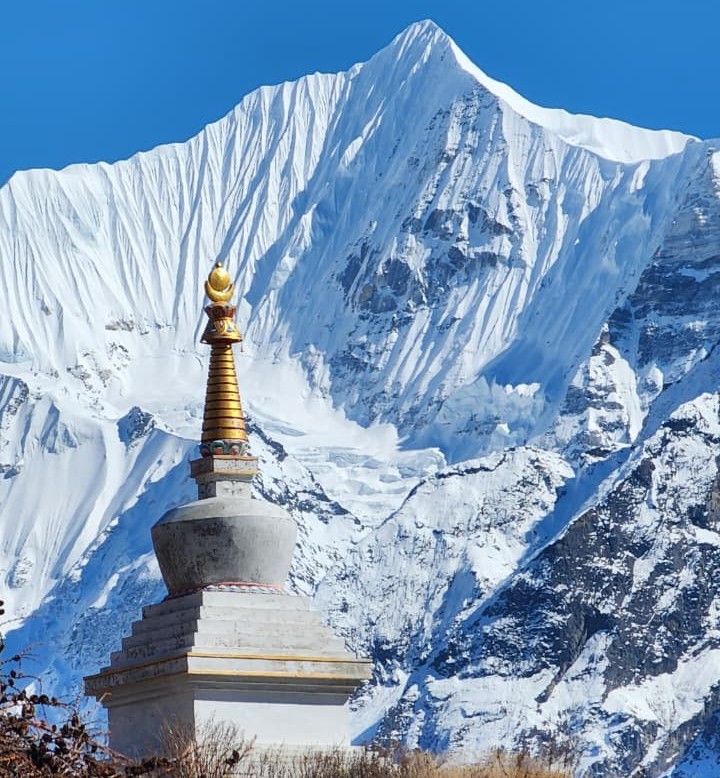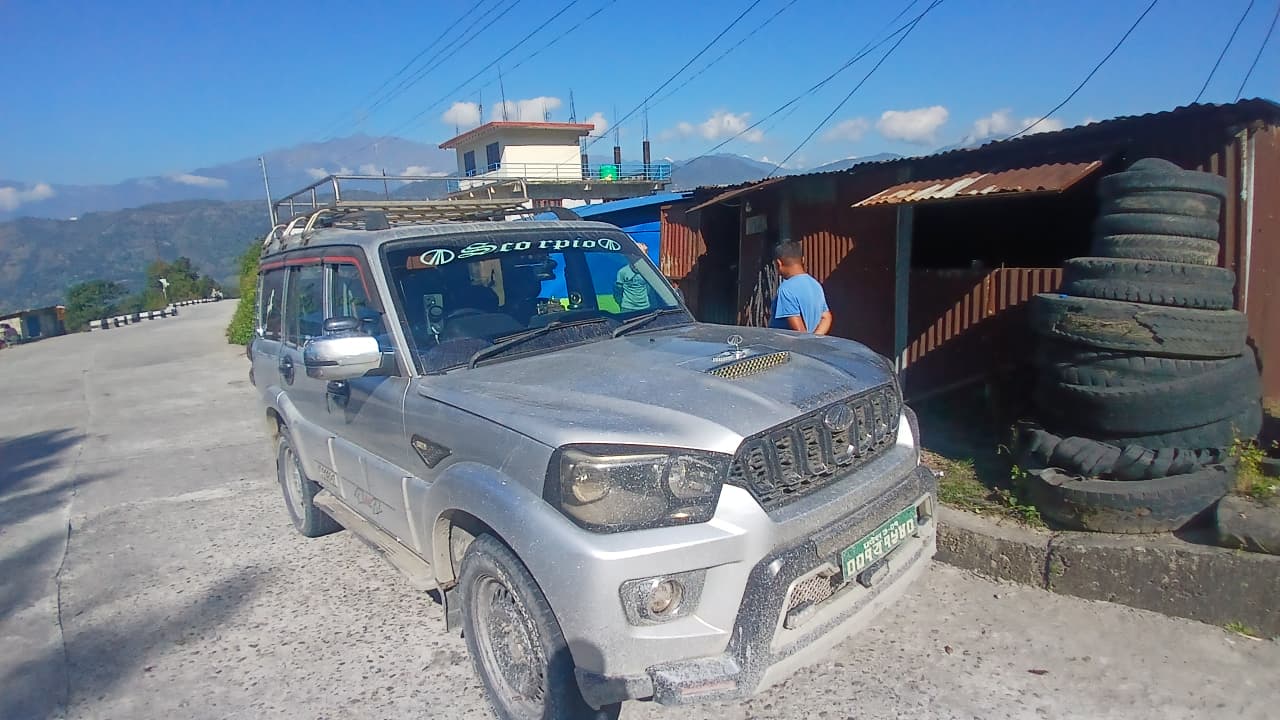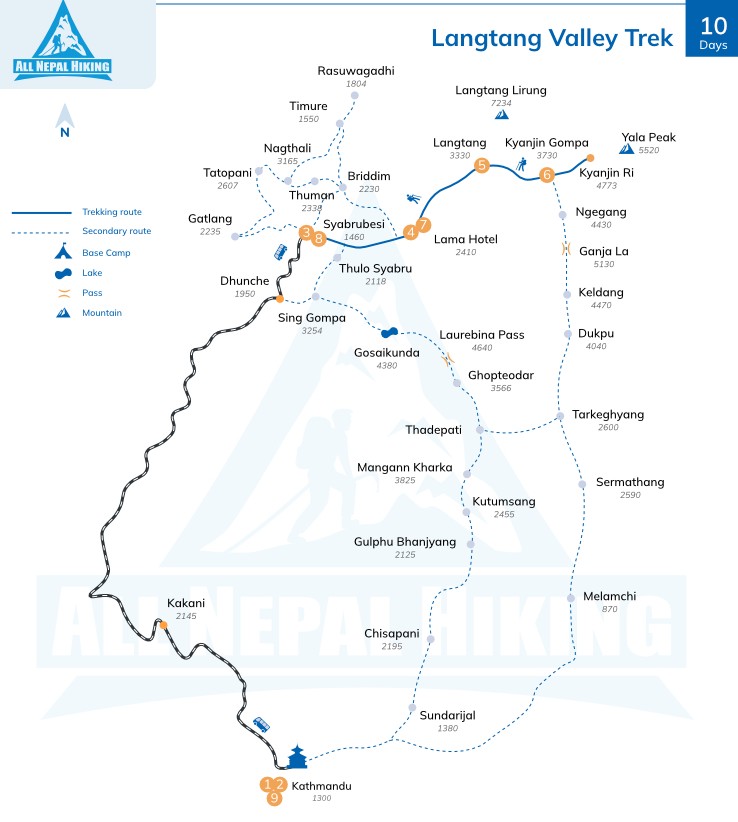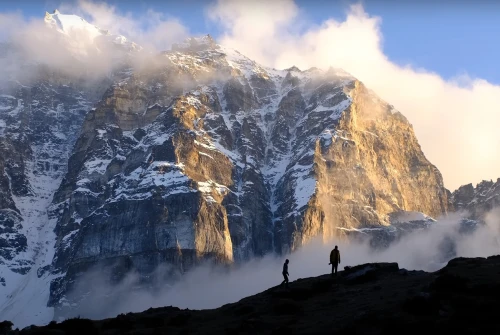Introduction to the Langtang Trek: Discover Nepal’s Hidden Himalayan Gem
Nestled just a short drive north of Kathmandu, the Langtang Trek offers one of the most captivating trekking experiences in Nepal. Often overshadowed by the more famous Everest and Annapurna trekking circuits, Langtang remains one of Nepal’s best-kept secrets, an untouched paradise that blends natural beauty, cultural heritage, and challenging landscapes in perfect harmony.
The Langtang Valley Trek takes you deep into the heart of the Langtang region, a stunning area surrounded by snow-capped peaks, verdant forests, and Tibetan-influenced villages. Known for its peaceful atmosphere, the trek is a quieter alternative to other more crowded routes, making it an ideal choice for trekkers seeking tranquility amid the grandeur of the Himalayas.
One of the biggest advantages of the Langtang Trek is its proximity to Kathmandu. With just a short drive to the trailhead at Syabrubesi, this trek is perfect for those with limited time but still yearning for an incredible Himalayan adventure. Despite its accessible starting point, the Langtang Trek offers a world-class experience, featuring breathtaking views of Langtang Lirung, Ganesh Himal, and several other towering peaks in the Langtang mountain range.
The trek also takes you through the Langtang National Park, a protected area rich in biodiversity, home to rare and endangered species such as the red panda, snow leopard, and Himalayan tahr. Along the way, you’ll encounter lush alpine meadows, rhododendron forests, and riverside trails that make the Langtang region a nature lover's paradise. You can also explore traditional Tamang villages, visit sacred Buddhist monasteries, and sample local delicacies like the famous yak cheese that the region is known for.
Whether you're a seasoned trekker or embarking on your first Himalayan adventure, the Langtang Trek offers a unique and diverse experience that combines breathtaking nature, vibrant culture, and challenging terrain. Ready to explore one of Nepal’s hidden gems? Let’s dive into the specifics of what makes the Langtang Valley Trek such a remarkable and unforgettable journey.

What Makes the Langtang Trek So Special?
The Langtang Trek is a hidden gem for trekkers seeking to escape the crowds of more popular Nepal trekking routes like the Everest Base Camp or the Annapurna Circuit. Located just a short distance from Kathmandu, Langtang offers a quieter, more intimate trekking experience, making it an ideal destination for those in search of tranquility, pristine nature, and stunning Himalayan views.
This trek takes you deep into Langtang National Park, a protected area that spans over 1,710 square kilometers of diverse landscapes. From lush rhododendron forests to vast alpine meadows and dramatic snow-capped peaks, the Langtang region offers an incredible range of natural beauty. Whether you’re trekking through valleys, crossing suspension bridges, or gazing at towering peaks like Langtang Lirung, the scenery is nothing short of spectacular.
What truly sets the Langtang Trek apart is its ability to offer both adventure and peace. While it’s close to Kathmandu, the trek remains less crowded, allowing trekkers to fully immerse themselves in the peaceful surroundings and experience the beauty of Nepal’s lesser-visited regions.
Langtang Village: A Glimpse Into the Mountain Way of Life
Langtang Village is the largest settlement you’ll encounter during the Langtang Trek, located at an altitude of 3,430 meters (11,253 feet). This village, once devastated by the 2015 earthquake, has been lovingly rebuilt and remains a central hub for trekkers passing through the Langtang Valley. It provides a unique opportunity to experience the Tamang culture and Tibetan influences that are deeply woven into the fabric of life in this remote Himalayan region.
The village is known for its welcoming atmosphere, where trekkers can enjoy a taste of local hospitality while immersed in the traditions of the Tamang people, an ethnic group with strong Tibetan roots. The Langtang Monastery, a key cultural site in the village, offers trekkers the chance to meet with local monks and learn about the Buddhist practices that have shaped the community for centuries. It’s a peaceful spot to absorb the region’s spiritual atmosphere, and visitors can also observe the serene rituals that are central to daily life in Langtang.
A unique highlight of Langtang Village is its famous yak cheese, produced locally at the village’s cheese factory. The cheese, made from the milk of the yaks that graze in the high-altitude pastures around the village, has become a signature product of the region. Trekkers often stop by to sample the delicious cheese and learn about the traditional methods used to produce it.
Whether you're exploring the Langtang Monastery, interacting with the warm and friendly locals, or tasting the region's famous yak cheese, Langtang Village offers an authentic and enriching experience that provides insight into the mountain way of life in the Langtang region. It’s a place where culture, tradition, and nature converge to create a memorable and rewarding stop on your journey through the Himalayas.

Langtang Lirung Peak: A Majestic Himalayan Giant
Langtang Lirung (7,227 meters) is the highest peak in the Langtang range, standing tall and proud as a majestic Himalayan giant. While it is not typically climbed by trekkers on the standard Langtang Trek, its presence looms large throughout the journey, offering trekkers awe-inspiring views and a sense of proximity to the mighty Himalayas.
The sheer height and scale of Langtang Lirung serve as a powerful reminder of the raw beauty and intensity of nature in this region. As you trek through the Langtang Valley, the peak is constantly visible, towering over the surrounding landscape. This towering sentinel of the region not only enhances the visual grandeur of the trek but also provides a backdrop that connects trekkers to the timeless power of the Himalayan mountains.
While summiting Langtang Lirung itself requires serious mountaineering skills and experience due to its technical difficulty and height, trekkers on the Langtang Trek are still treated to incredible panoramic views of the peak from Kyanjin Ri (4,700 meters), the highest point on the trek. From this vantage point, you can gaze upon Langtang Lirung in all its glory, as well as other neighboring peaks like Dorje Lakpa and Gangchempo, making the Kyanjin Ri hike one of the highlights of the journey.
Although Langtang Lirung remains elusive for most trekkers, its towering presence and breathtaking views are a testament to the grandeur of the Langtang Himal. For many, simply being in the shadow of this Himalayan giant provides a deep sense of fulfillment and awe, making the Langtang Trek a truly unforgettable experience.

Langtang National Park: A Biodiversity Hotspot
Langtang National Park is a biodiversity-rich treasure that ranks among Nepal’s most prized natural reserves. Situated in the heart of the Langtang region, the park spans over 1,710 square kilometers of pristine wilderness, offering trekkers and nature enthusiasts an unparalleled opportunity to explore the beauty of the Himalayas and its diverse ecosystems.
The park is renowned for its rich flora and fauna, with dense forests filled with rhododendron, pine, and oak trees that are home to a variety of wildlife. Some of the park’s most iconic and elusive residents include the red panda, Himalayan tahr, snow leopard, and musk deer, making it a must-visit destination for wildlife lovers and photographers.
Langtang National Park is not only famous for its larger mammals but also for its exceptional birdlife. Birdwatchers will find the park a paradise, with species such as the Himalayan griffon vulture, the striking monal pheasant, and several other high-altitude bird species, including migratory birds that make the park their home during different seasons. The park's varied altitudes and ecosystems provide habitats for a rich diversity of species, some of which are endangered or rare, making Langtang an ecologically significant region.
In addition to its natural beauty, Langtang National Park offers trekkers a rare chance to experience the Himalayan ecosystem up close. As you walk through its forests, cross alpine meadows, and navigate rugged mountain terrain, you will witness the untouched grandeur of a truly special place.
For those interested in both natural beauty and conservation, Langtang National Park is an essential stop during the Langtang Trek, offering a unique blend of adventure and ecological exploration.

Langtang Trek from Kathmandu: Quick Access to Nepal's Himalayas
The Langtang Trek from Kathmandu is one of the shortest routes to access the majestic Himalayas, making it an ideal choice for trekkers looking for an accessible yet unforgettable trekking experience. The journey begins with a scenic drive (or private jeep ride) from Kathmandu to Syabrubesi, the starting point of the trek. The drive typically takes 7-8 hours and offers trekkers their first views of Nepal’s stunning landscapes, including terraced fields, rivers, and the picturesque foothills of the Himalayas.
Despite being relatively short in terms of distance, the trek quickly takes you deep into the Himalayas, offering a unique combination of cultural immersion and breathtaking natural beauty. As you move further into the Langtang Valley, the trek offers sweeping views of towering peaks like Langtang Lirung (7,227 meters) and Ganesh Himal, along with a journey through Tamang villages, where you can experience traditional mountain culture and Buddhist influences.
One of the biggest draws of the Langtang Trek is its proximity to Kathmandu, making it much more accessible than other popular treks such as the Everest Base Camp or Annapurna Circuit. This makes the Langtang Valley Trek an attractive option for trekkers with limited time but still eager to experience the stunning beauty and culture of the Himalayas.
While the Everest and Annapurna regions may draw more attention from international trekkers, the Langtang Valley Trek is considered a hidden gem. Its relatively low foot traffic, coupled with the easy access from Kathmandu, makes it an ideal trek for those looking to enjoy the mountains without the crowds typically found in other more famous regions. The combination of seclusion, natural beauty, and cultural experiences makes the Langtang Trek a truly unique adventure.

Langtang Valley Trek Altitude: Key Milestones and Trekking Heights
The Langtang Trek is known for its moderate-to-challenging altitude, making it a great choice for trekkers who are looking for a rewarding high-altitude adventure without the extreme conditions of higher Himalayan treks like Everest Base Camp or Annapurna Circuit. The trek reaches an elevation of over 4,700 meters (15,420 feet) at the Kyanjin Ri viewpoint, which offers trekkers some of the most stunning panoramic views in the entire Langtang region, including the towering Langtang Lirung (7,227 meters).
While Langtang Valley Trek altitude is manageable for most, proper acclimatization is key to preventing altitude sickness. Here's a quick guide to the Langtang Trek altitude milestones:
- Kathmandu (1,300 meters / 4,265 feet): The starting point of your journey. From Kathmandu, you’ll take a scenic drive to the trailhead at Syabrubesi.
- Syabrubesi (1,460 meters / 4,790 feet): The trek officially begins here. It’s a bustling village and the gateway to the Langtang region.
- Lama Hotel (2,470 meters / 8,104 feet): The first major stop after a beautiful hike through forests. This area provides the first taste of the region’s natural beauty.
- Langtang Village (3,430 meters / 11,253 feet): Situated deep in the heart of the Langtang region, this village was historically the main settlement in the area and is surrounded by stunning mountain views.
- Kyanjin Gompa (3,800 meters / 12,467 feet): A sacred Buddhist monastery. Kyanjin Gompa is a peaceful retreat where you’ll also find a small cheese factory and a breathtaking view of the peaks above.
- Kyanjin Ri (4,700 meters / 15,420 feet): The highest point of the trek, where trekkers are rewarded with one of the best Himalayan views available anywhere. From here, you can see Langtang Lirung, Dorje Lakpa, and numerous other peaks of the Langtang mountain range.
At Kyanjin Ri, trekkers are treated to a 360-degree view of the surrounding Himalayan giants, including the Langtang range, making it one of the trek's most rewarding and unforgettable experiences.
Langtang Valley Trek Trekking Duration: How Long Does the Langtang Trek Take?
The Langtang Valley Trek is a scenic and relatively accessible trek in Nepal, offering a one-way distance of approximately 37 kilometers (23 miles). The overall round-trip trek is about 74 kilometers (46 miles), which is typically completed in 7-10 days, depending on pace and acclimatization.
Kathmandu to Syabrubesi: The Journey Begins
The trek starts with a scenic 7-8 hour drive from Kathmandu to Syabrubesi, covering a distance of approximately 120 kilometers (75 miles). The drive passes through lush valleys, terraced fields, and rivers, offering a beautiful introduction to the landscapes you will encounter on the trek.
From Syabrubesi, you’ll begin your trek towards the Langtang Valley, passing through forests, traditional villages, and along the Langtang River, all the while enjoying incredible views of the Langtang range.
Trek Distance & Terrain
- One-Way Trek Distance: 37 kilometers (23 miles) from Syabrubesi to Kyanjin Gompa.
- Round-Trip Distance: The total round-trip trekking distance is approximately 74 kilometers (46 miles), depending on your route and any side excursions (like the Kyanjin Ri hike).
- Terrain: The trek involves a mix of forests, rivers, alpine meadows, and villages, with stunning views of peaks such as Langtang Lirung and Ganesh Himal.
Trekking Duration
The trek typically takes 7-10 days, depending on your pace and how much time you spend acclimatizing. The higher altitudes, especially at Kyanjin Ri (4,700 meters / 15,420 feet), make it essential to acclimatize properly to prevent altitude sickness.

Langtang in Nepali: A Local Touch
In Nepali, Langtang is written as लाङटाङ. The name "Langtang" has its origins in the Tamang language, with one popular interpretation being "shepherd's place". This name likely reflects the region’s long history as a grazing ground for yaks and livestock, which were traditionally herded by the Tamang people who call this stunning valley their home.
This deep connection to livestock herding and the Tamang way of life is evident throughout the trek. As you journey through the Langtang Valley, you’ll pass through traditional Tamang villages, where you’ll see stone houses, yak caravans, and ancient monasteries that maintain a strong connection to Tibetan Buddhist traditions. These cultural elements provide trekkers with a rich experience that combines the beauty of the landscape with the warmth and hospitality of the local people.
Most of the locals in the Langtang region are Tamang people, who speak both Nepali and Tibetan dialects. This bilingual aspect gives trekkers the opportunity to experience the cultural diversity of the region. Along the way, you may interact with monks, local villagers, and herders, gaining insights into their way of life, beliefs, and traditions.
The Tamang influence is also reflected in the architecture of the region’s Buddhist monasteries, where you’ll find prayer flags, mani stones, and chortens, all symbols of the Tibetan Buddhist faith. The monasteries not only offer spiritual solace but also provide a glimpse into the peaceful and devout lifestyle of the region’s inhabitants.
Best Time to Trek Langtang: When to Experience the Himalayas at Their Best
The best time to trek in the Langtang region is during the spring (March to May) and autumn (September to November) seasons. These months offer the perfect combination of clear skies, moderate temperatures, and stable weather conditions, making them ideal for a trek through the Langtang Valley.
Spring (March to May): A Vibrant Journey Amid Nature's Bloom
Spring is one of the most magical times to trek Langtang, especially for nature lovers and photographers. This season brings the rhododendron forests into full bloom, blanketing the valley in shades of red, pink, and white. The weather is pleasantly mild, and trekking conditions are comfortable, with daytime temperatures ranging from 10°C to 20°C (50°F to 68°F). This season is also less crowded compared to autumn, allowing for a more peaceful experience along the trail.
The clear skies and stunning mountain views make spring an ideal time for trekking. If you're someone who enjoys seeing the natural world in full color, this is the time for you. Plus, spring is perfect for those wanting to experience the biodiversity of Langtang, as it’s when many wildflowers bloom, adding to the already spectacular landscapes.
Autumn (September to November): Clear Views and Perfect Trekking Conditions
Autumn is arguably the best time to trek Langtang, particularly for those who want to see the Himalayas in all their glory. Following the monsoon, the weather is crystal-clear, offering unmatched visibility of peaks like Langtang Lirung and Ganesh Himal. The cool, dry weather and moderate temperatures (ranging from 5°C to 15°C/41°F to 59°F) make autumn trekking ideal—perfect for those seeking comfortable conditions and stunning mountain vistas.
Autumn is also the peak trekking season in Nepal, so while you can expect more trekkers on the trail, the trade-off is the availability of better services, accommodations, and clearer trails. If you’re a photographer or simply want to experience Langtang's towering peaks at their most majestic, autumn is the season to go.
Langtang Trek Itinerary: A Day-by-Day Guide to Nepal’s Hidden Himalayan Gem
The Langtang Trek is a relatively moderate trek that takes you deep into the heart of the Langtang Valley. With breathtaking mountain views, beautiful forests, and unique cultural experiences, this trek is perfect for those looking to explore Nepal's Himalayas without the intensity of the Everest or Annapurna regions. Below is a typical Langtang Trek itinerary that spans 7 days, with ample time to acclimatize and explore.
Day 1: Kathmandu to Syabrubesi (1,460 meters)
Your journey begins with a scenic 7-8 hour drive from Kathmandu to Syabrubesi, the trailhead of the Langtang Trek. The drive takes you through beautiful landscapes, winding along rivers, and offering views of terraced fields and mountain ridges. Syabrubesi is a small, bustling village that serves as the gateway to Langtang Valley. Take the rest of the day to relax and prepare for the trek ahead.
Day 2: Syabrubesi to Lama Hotel (2,470 meters)
After a hearty breakfast, your trek begins! Today’s journey is a gradual ascent, passing through lush forests of oak, rhododendron, and bamboo. You'll cross small suspension bridges and pass through local settlements along the way. As you trek through the serene forest, keep an eye out for wildlife, including the elusive red panda.
- Distance: 12-14 km
- Overnight: Lama Hotel
Day 3: Lama Hotel to Langtang Village (3,430 meters)
Today’s trek takes you deeper into the heart of the Langtang Valley. The trail passes through bamboo forests and small villages, offering stunning views of the surrounding peaks. As you approach Langtang Village, you’ll be greeted by towering views of Langtang Lirung (7,227 meters). Langtang Village was heavily affected by the 2015 earthquake, but it has been rebuilt and remains a key stop for trekkers in the region.
- Distance: 11-14 km
- Overnight: Langtang Village
Day 4: Langtang Village to Kyanjin Gompa (3,800 meters)
This is a shorter day, with a trek of around 4-5 hours. The trail climbs steadily through scenic alpine meadows and yak pastures, offering panoramic views of the surrounding peaks. Kyanjin Gompa, a sacred Buddhist monastery, sits at the foot of Langtang Lirung. From here, you’ll have stunning views of the Langtang Himal and the opportunity to explore the monastery.
- Distance: 6-8 km
- Overnight: Kyanjin Gompa
Day 5: Day Trip to Kyanjin Ri (4,700 meters)
To make the most of the incredible views, you’ll take a side trip to Kyanjin Ri today. This short but steep hike takes you to an altitude of 4,700 meters, offering breathtaking panoramic views of the Langtang range, including Langtang Lirung, Dorje Lakpa, and Ganja La Pass. After soaking in the views, you’ll return to Kyanjin Gompa to rest and acclimatize.
- Distance: 8-10 km (round trip)
- Overnight: Kyanjin Gompa
Day 6: Descend to Lama Hotel
After spending a night in the peaceful Kyanjin Gompa, it’s time to retrace your steps. Today’s descent takes you back through the same lush forests, crossing rivers and passing through villages. It’s easier on your body after the higher-altitude trek, but be mindful of your knees while descending.
- Distance: 17-20 km
- Overnight: Lama Hotel
Day 7: Lama Hotel to Syabrubesi
Today is the final descent back to Syabrubesi. The journey is a bit easier now, as you pass through the same trails, but the beauty of the landscape remains unchanged. You’ll have one last chance to reflect on your trek and enjoy the stunning surroundings before heading back to the village.
- Distance: 12-14 km
- Overnight: Syabrubesi
Day 8: Drive Back to Kathmandu
After a hearty breakfast, take a scenic drive back to Kathmandu. The return journey takes about 7-8 hours, but it’s a great way to relax and reflect on the incredible experiences and memories you’ve made. Upon arrival in Kathmandu, you’ll have the chance to rest, explore the city, or simply relax after your adventurous trek.
- Distance: 120 km (drive)
- Overnight: Kathmandu
Conclusion: Why You Should Trek Langtang with All Nepal Hiking
The Langtang Trek offers trekkers an unforgettable journey, blending breathtaking mountain views, rich cultural heritage, and peaceful, less crowded trails. Whether you're an experienced trekker or someone looking for a moderate challenge, Langtang provides the perfect mix of adventure and serenity.
From the tranquil Langtang Valley to the towering Langtang Lirung and other majestic peaks, this trek takes you through Nepal's stunning natural beauty and vibrant mountain cultures. The route also takes you through the Langtang National Park, a biodiversity hotspot full of incredible wildlife, rare species like the red panda, and diverse alpine flora. It’s not just a trek; it’s an educational and immersive experience in the heart of the Himalayas.
With its moderate altitude, accessible trekking duration, and proximity to Kathmandu, the Langtang Valley Trek is an ideal option for those who want to experience the grandeur of the Himalayas without the challenges of higher-altitude treks like Everest or Annapurna. The trek offers the perfect balance of physical challenge, cultural exploration, and natural beauty.
If you're planning your next adventure in Nepal, the Langtang Trek should definitely be on your list. It’s a unique and rewarding experience that will leave you with lasting memories of stunning landscapes, meaningful cultural exchanges, and a deeper connection to the Himalayas.
Ready to Trek Langtang with All Nepal Hiking?
At All Nepal Hiking, we specialize in creating personalized trekking experiences that cater to your needs and comfort level. Whether you need help planning your Langtang Trek itinerary, booking permits, or arranging local guides, we are here to assist you every step of the way.
If you’re ready to experience the beauty of Langtang for yourself, feel free to reach out to us today! Let us help you turn your Himalayan dream into a reality.









 based on 3 reviews
based on 3 reviews
.webp)

